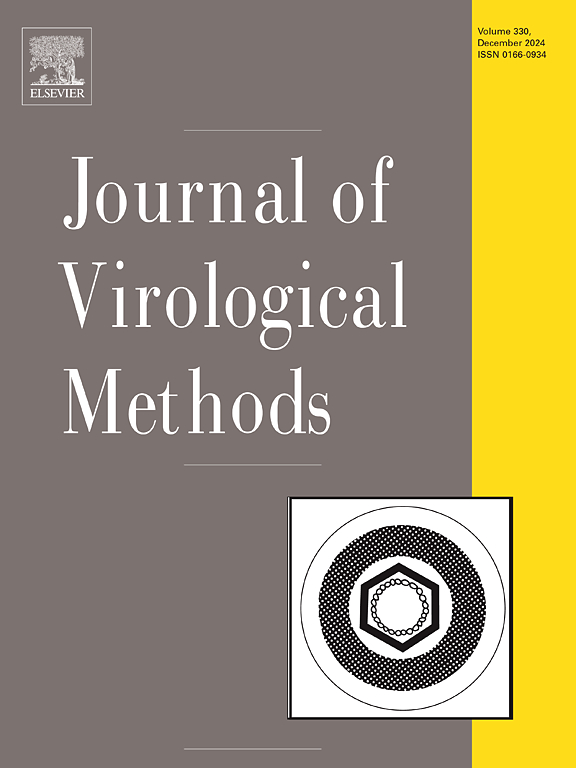血清、肝脏和组织培养中多种乙型肝炎剪接变异体的高维液滴数字PCR
IF 1.6
4区 医学
Q3 BIOCHEMICAL RESEARCH METHODS
引用次数: 0
摘要
乙型肝炎病毒(HBV)影响约20亿人;2.54亿人患有慢性感染。剪接HBV (spHBV) rna在人类感染中的作用尚不清楚,部分原因是定量方法的限制。我们设计了长扩增子(0.3-2kbp) ddPCR检测,同时定量最常见的spHBV亚型(sp1, sp2, sp3, sp8, sp9)和未剪接的基因组前RNA (pgRNA)。我们的创新包括使用ddPCR、长扩增子和高维多路复用。我们对引物和探针在合成DNA靶标上进行qPCR测试,以鉴定高保真度的HBV基因型a病毒组合。使用共同的正向和反向引物,我们解释了不同大小的扩增子之间的PCR效率差异。我们改变了变性和退火温度,以丰富spHBV,总HBV RNA的少数群体。为了实现高阶多路转换,我们将循环数增加到80个,增加了逆转录后清理步骤,并测试了>; 360个寡核苷酸浓度组合。我们对肝组织进行了空间转录组测序,以证实ddPCR测量的剪接连接。我们成功地定量了血清、肝脏和hbv感染的HepG2NTCP细胞中的spHBV和pgRNA。我们的检测方法能够直接、灵敏地定量测定血清、肝脏和组织培养样本中的spHBV和全长pgRNA,这将有助于研究spHBV对人类HBV感染结果的影响。该技术在HBV研究和治疗开发中具有潜在的应用前景,在病毒学和肿瘤学方面具有更广泛的意义。本文章由计算机程序翻译,如有差异,请以英文原文为准。
High-dimensional droplet digital PCR of multiple hepatitis B splice variants in serum, liver, and tissue culture
Hepatitis B virus (HBV) affects approximately 2 billion individuals; 254 million have chronic infection. The roles of spliced HBV (spHBV) RNAs in human infection are poorly understood partly due to limitations in quantitative methods. We designed and multiplexed long amplicon (0.3–2kbp) ddPCR assays that simultaneously quantify the most frequently observed spHBV isoforms (sp1, sp2, sp3, sp8, sp9) alongside unspliced pregenomic RNA (pgRNA). Our innovations include the use of ddPCR, long amplicons, and high-dimensional multiplexing. We tested primers and probes using qPCR on synthetic DNA targets to identify a high-fidelity combination recognizing HBV genotype A viruses. Using common forward and reverse primers we accounted for PCR efficiency differences between amplicons of differing size. We altered denaturation and annealing temperatures to enrich spHBV, the minority population of total HBV RNA. To achieve higher-order multiplexing, we increased the number of cycles to 80, added a post-reverse transcription cleanup step, and tested > 360 oligo concentration combinations. We performed spatial transcriptomic sequencing on liver tissue to confirm splice junctions measured by ddPCR. We successfully quantified spHBV and pgRNA in serum, liver, and HBV-infected HepG2NTCP cells. Our assay enables direct, sensitive quantification of spHBV and full-length pgRNA from serum, liver, and tissue culture samples, which will facilitate studies on the impact of spHBV on HBV infection outcomes in people. This technique has potential applications in HBV research and therapy development, with broader implications in virology and oncology.
求助全文
通过发布文献求助,成功后即可免费获取论文全文。
去求助
来源期刊
CiteScore
5.80
自引率
0.00%
发文量
209
审稿时长
41 days
期刊介绍:
The Journal of Virological Methods focuses on original, high quality research papers that describe novel and comprehensively tested methods which enhance human, animal, plant, bacterial or environmental virology and prions research and discovery.
The methods may include, but not limited to, the study of:
Viral components and morphology-
Virus isolation, propagation and development of viral vectors-
Viral pathogenesis, oncogenesis, vaccines and antivirals-
Virus replication, host-pathogen interactions and responses-
Virus transmission, prevention, control and treatment-
Viral metagenomics and virome-
Virus ecology, adaption and evolution-
Applied virology such as nanotechnology-
Viral diagnosis with novelty and comprehensive evaluation.
We seek articles, systematic reviews, meta-analyses and laboratory protocols that include comprehensive technical details with statistical confirmations that provide validations against current best practice, international standards or quality assurance programs and which advance knowledge in virology leading to improved medical, veterinary or agricultural practices and management.

 求助内容:
求助内容: 应助结果提醒方式:
应助结果提醒方式:


